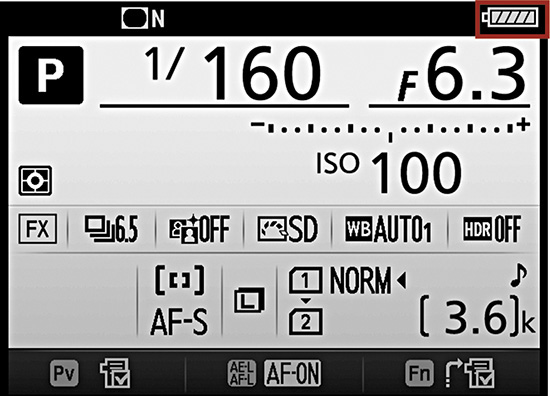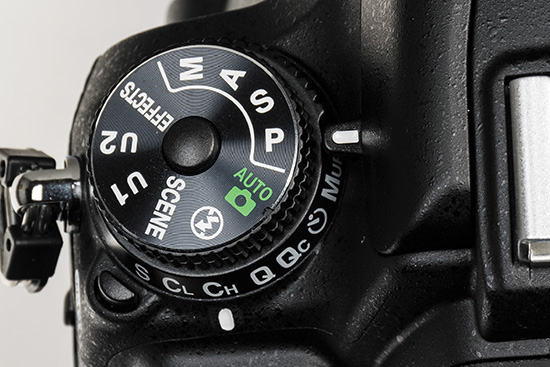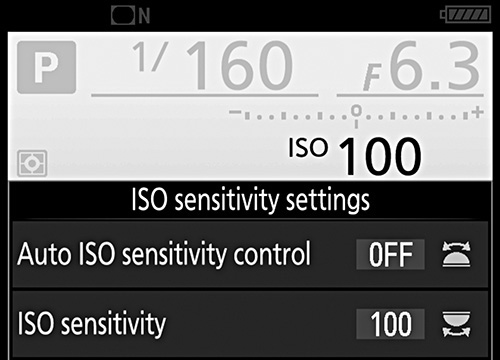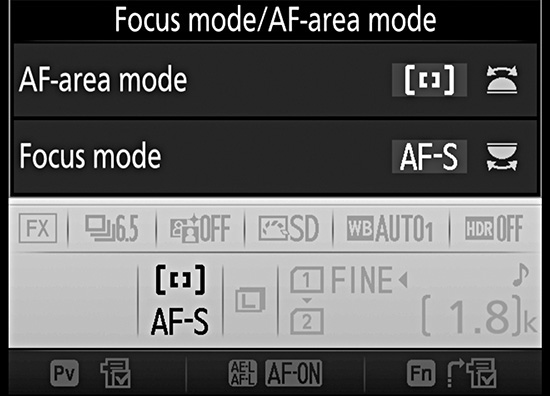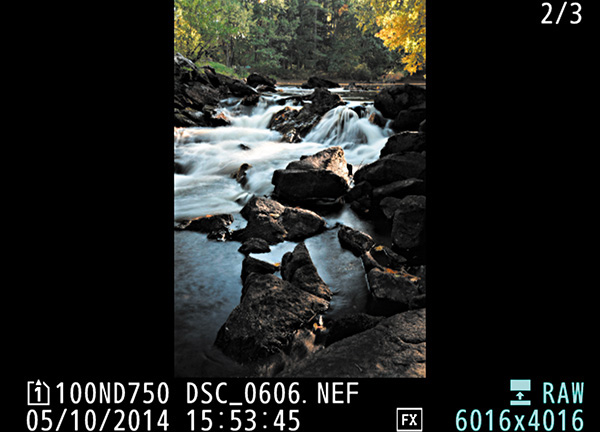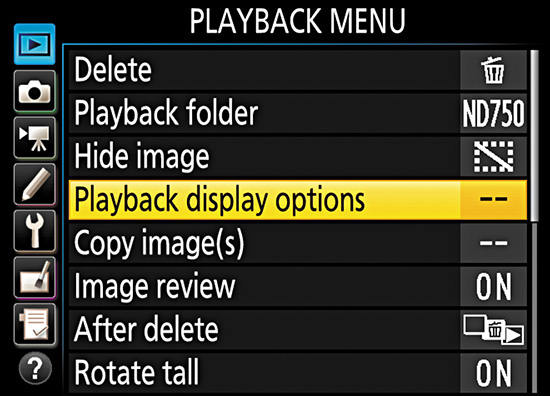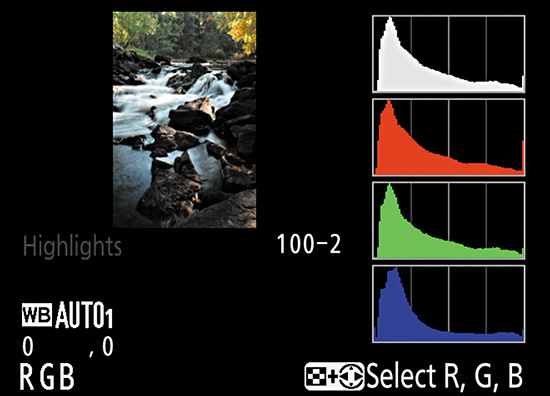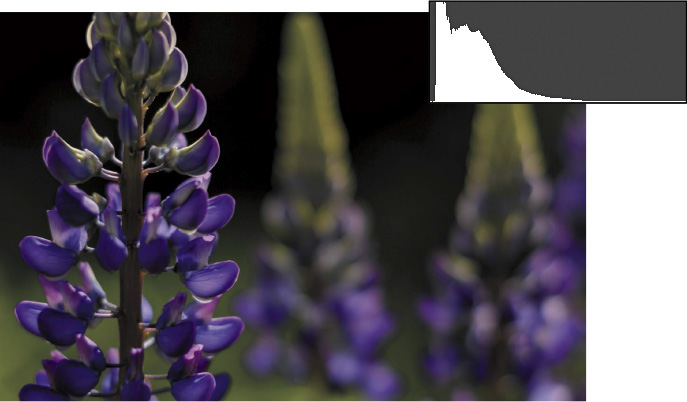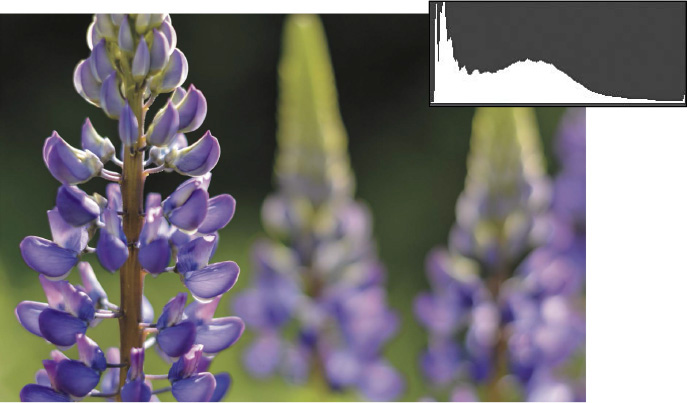1. The D750 Top Ten List

ISO 100 • 1/20 sec. • f/16 • 24mm lens
Ten Tips to Make Your Shooting More Productive Right Out of the Box
Whenever I get a new camera, I am always anxious to jump right in and start cranking off exposures. What I really should be doing is sitting down with my instruction manual to learn how to use all of the camera features, but what fun is that? After all, we all know that instruction manuals are for propping up that short leg on the family room table, right?
Of course, this behavior always leads me to frustration in the end—there are always issues that could have been easily addressed had I known about them before I started shooting. Maybe if I had a Top Ten list of things to know, I could be more productive without having to spend countless hours with the manual. So this is where we begin.
The following list will get you up and running without suffering many of the “gotchas” that come from not being at least somewhat familiar with your new camera. So let’s take a look at the top ten things you should know before you start taking pictures with your Nikon D750.
Poring Over the Camera
Camera Front

A AF-assist illuminator
B Stereo microphone
C Lens mounting mark
D Infrared receiver
E Lens release button
F AF-mode button
G Focus-mode selector
H Fn (Function) button
I Depth of field preview button
J Sub-command dial
Camera Back
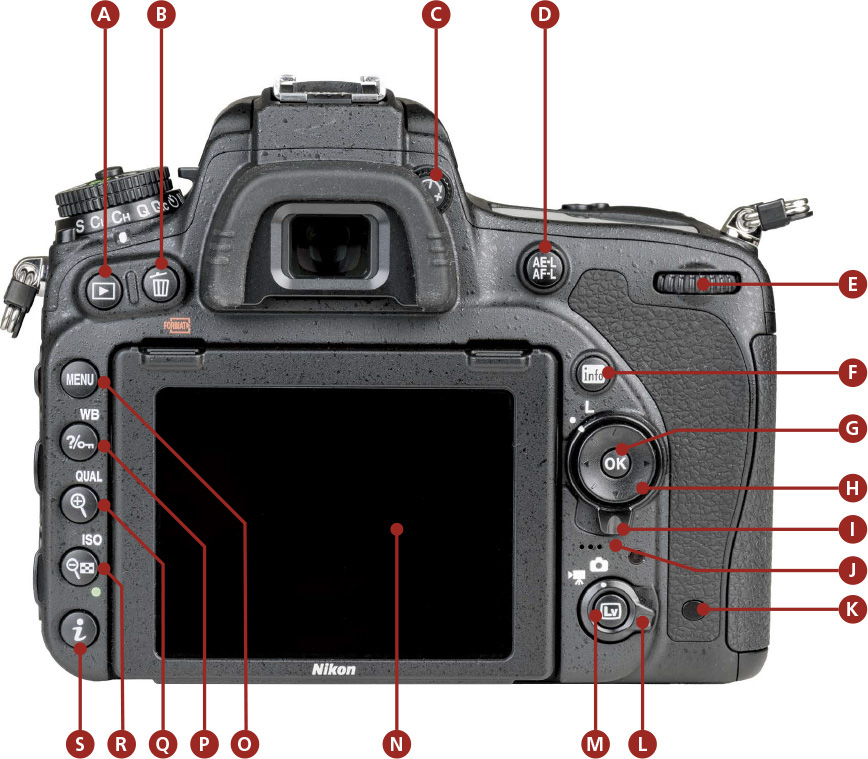
A Playback button
B Delete button
C Diopter
D AutoExposure/AutoFocus lock button
E Main Command dial
F Info button
G OK button
H Multi-selector
I Focus selector lock
J Speaker
K Infrared receiver
L Live view selector
M Live view button
N Tilting monitor/information screen
O Menu button
P Help/Protect/White Balance button
Q Playback zoom in/Image quality button
R Playback zoom out/ISO button
S i button
Poring Over the Camera
Camera Top
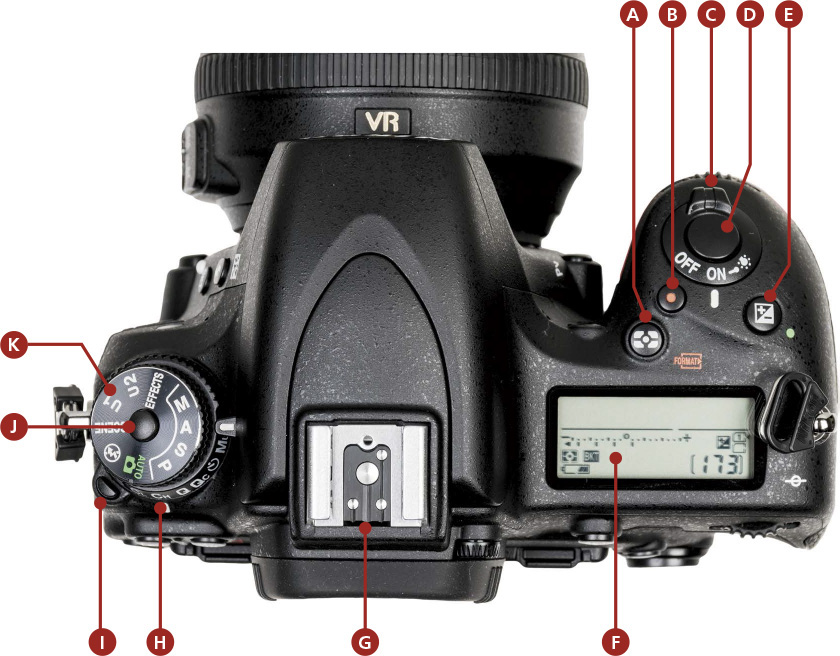
A Metering button
B Movie-record button
C Power switch
D Shutter release button
E Exposure compensation/aperture adjustment
F Control panel
G Accessory shoe
H Release mode dial
I Release mode dial lock release
J Mode dial lock release
K Mode dial
1. Charge Your Battery
I know that this will be one of the hardest things for you to do because you really want to start shooting, but a little patience will pay off later.
When you first open your camera and slide the battery into the battery slot, you will be pleased to find that there is probably juice in the battery and you can start shooting right away. What you should really be doing is getting out the battery charger and giving that power cell a full charge. Not only will this give you more time to shoot, it will start the battery off on the right foot. No matter what claims the manufacturers make about battery life and charging memory, I always find I get better life and performance when I charge my batteries fully and then use them right down to the point where they have nothing left to give. To check your battery level, put the battery in the camera, turn the camera on, and look for the battery indicator in the lower-left section of the top LCD screen. You can also see the battery level by pressing the Info button on the back of the camera and then locating the battery meter on the top right of the rear information screen (Figure 1.1).
2. Set Your JPEG Image Quality
Your new D750 has a number of image quality settings to choose from, and you can adjust them according to your needs. Most people start shooting with the JPEG option because it allows them to capture a large number of photos on their memory cards and not have to deal with as much software processing later. The problem is that unless you understand what JPEG is, you might be degrading the quality of your images without realizing it.
The JPEG (Joint Photographic Experts Group) format has been around since about 1994 and was developed as a method of reducing large file sizes while retaining the original image information. (Technically, JPEG isn’t even a file format—it’s a mathematical equation for reducing image file sizes—but to keep things simple, we’ll just refer to it as a file format.) The problem with JPEG is that, in order to reduce file size, it has to throw away some of the information. This is referred to as “lossy compression.” This is important to understand, because while you can fit more images on your memory card by choosing a lower-quality JPEG setting, you will also be reducing the quality of your image. This effect becomes more apparent as you enlarge your pictures.
The JPEG file format also has one other characteristic: to apply the compression to the image before final storage on your memory card, the camera first applies all of the image processing. Image processing involves such factors as sharpening, color adjustment, contrast adjustment, noise reduction, and so on. Many photographers now prefer to use the raw file format to get greater control over the image processing. We will take a closer look at this in Chapter 2, but for now let’s just make sure that we are using the best-quality JPEG possible.
The D750 has nine settings for the JPEG format. There are three settings each for the Large, Medium, and Small image size settings. The three settings (Basic, Normal, and Fine) represent more or less image compression based on your choice. The Large, Medium, and Small settings determine the actual physical size of your image in pixels. Let’s work with the highest-quality setting possible. After all, our goal is to make big, beautiful photographs, so why start the process with a lower-quality image?
1. Press and hold the QUAL button on back of the camera to activate the image quality settings on the information screen.
2. Use the Main Command dial to select the Fine quality setting (A).

3. To adjust the image size, rotate the Sub-command dial (B).
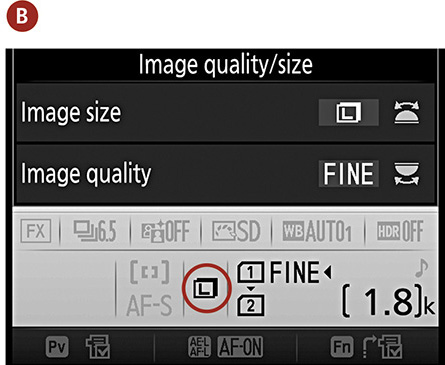
As you will see when scrolling through the quality settings, the higher the quality, the fewer pictures you will be able to fit on your card. If you have a 16 GB memory card, the quality setting we have selected will allow you to shoot about 923 photographs before you fill up your card. Always try to choose quality over quantity. Your pictures will be the better for it.
3. Set the Correct White Balance
White balance correction is the process of rendering accurate colors in your final image. Most people don’t even notice that light has different color characteristics, because the human eye automatically adjusts to changes in color temperature—so quickly in fact that everything looks correct in a matter of milliseconds.
When color film ruled the world, photographers would select which film to use depending on what their light source was going to be. The most common film was balanced for daylight, but you could also buy film that was color balanced for tungsten light sources. Most other lighting situations had to be handled by using color filters over the lens. This process was necessary for the photographer’s final image to show the correct color balance of a scene.
Your camera has the ability to perform this same process automatically, but you can also choose to override it and set it manually. Guess which method we are going to use? That’s right, once again your photography should be all about maintaining control over everything that influences your final image.
Luckily, you don’t need to have a deep understanding of color temperatures to control your camera’s white balance. The choices are given to you in terms that are easy to relate to and that will make things pretty simple. Your white balance choices are:
• Auto: The camera determines the best white balance setting and adjusts accordingly. Very useful in mixed lighting situations.
• Incandescent: Used for any occasion where you are using regular household-type bulbs for your light source. Tungsten is a very warm light source and will result in a yellow/orange cast if you don’t correct for it.
• Fluorescent: Used to get rid of the green-blue cast that can result from using regular fluorescent lights as your dominant light source.
• Direct sunlight: Most often used for general daylight/sunlit shooting.
• Flash: Used whenever you’re using the built-in flash or a flash on the hot shoe. You should select this white balance to adjust for the slightly cooler light that comes from using a flash. (The hot shoe is the small bracket that rests just above the eyepiece on the top of your camera. This bracket is used for attaching a more powerful flash to the camera; see Chapter 8 for more information.)
• Cloudy: The choice for overcast or very cloudy days. This and the Shade setting will eliminate the blue color cast from your images.
• Shade: Used when working in shaded areas that are still using sunlight as the dominant light source.
• Kelvin: This setting works well when you know the actual Kelvin temperature (color) of the lights that you are working with.
• Pre: Indicates that you are using a customized white balance that is adjusted for a particular light source. This option can be adjusted using an existing photo you have taken or by taking a picture of something white or gray in the scene.
Your camera has two different “zones” of shooting modes to choose from. These are located on the Mode dial, which separates your choices into automatic scene modes and what I refer to as the professional modes. None of the automatic modes, which are chosen by turning the Mode dial to Auto, Flash Off, Effects, or Scene, allow for much customization, including white balance. The professional modes, defined by the letter symbols M, A, S, P, U1, and U2, allow for much more control by the photographer (Figure 1.2).
Figure 1.2 The camera’s shooting modes are divided into the automatic scene modes and the professional modes (M, A, S, P, U1, and U2).
Setting the white balance
1. After turning on or waking the camera, select one of the professional shooting modes, such as P (you can’t select the white balance when using any of the automatic modes).
2. Press and hold the WB button located on the back of the camera to activate White Balance, visible on the rear information screen.
3. Rotate the Main Command dial to change the white balance mode.
4. If you want to use the Kelvin setting, rotate the Main Command dial to set the white balance to Kelvin and then use the Sub-command dial to set the desired temperature setting.
4. Set Your Color Space
The color space deals with how your images will ultimately be used. It is basically a set of instructions that tells your camera how to define the colors in your image and then output them to the device of your choice, be it your monitor or a printer. Your camera has a choice of two color spaces: sRGB and Adobe RGB.
The first choice, sRGB, was developed by Hewlett-Packard and Microsoft as a way of defining colors for the Internet. This space was created to deal with the way that computer monitors actually display images using red, green, and blue (RGB) colors. Because there are no black pixels in your monitor, the color space uses a combination of these three colors to display all of the colors in your image.
In 1998, Adobe Systems developed a new color space, Adobe RGB, which was intended to encompass a wider range of colors than was obtainable using traditional cyan, magenta, yellow, and black colors (called CMYK) but doing so using the primary red, green, and blue colors. It uses a more widely defined palette of colors than the sRGB space and, therefore, looks better when printed.
The choice you need to make when selecting your color space is based on whether you intend to use your photographs for prints (Adobe RGB) or for online and mobile applications (sRGB). I typically use the Adobe RGB space when shooting because I like to print a lot of my images. If I decide to use them online, I use my image software application to convert them to the sRGB color space. It is always better to go from a larger color space to a smaller one. If you decide to shoot raw, which we’ll cover in the next chapter, it doesn’t matter which color space you choose in camera because raw doesn’t have a color space and you’ll choose your color space based on your output needs at the time.
Setting the color space
1. With the camera turned on, press the Menu button.
2. Using the Multi-selector, select the Shooting menu and then highlight the Color space option. Press the OK button (A).
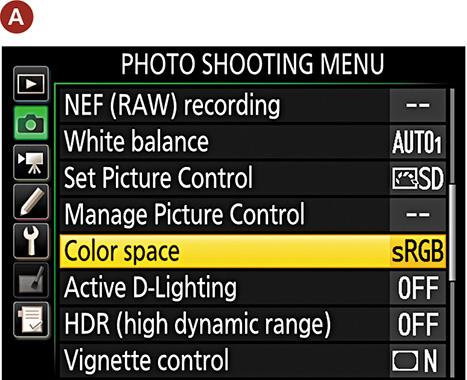
3. Highlight your desired color space, and press the OK button once again (B).
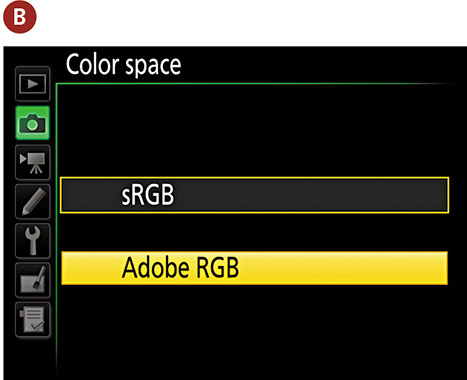
4. Press the Menu button or the shutter release button to return to shooting mode.
One way to tell which color space is being used is by looking at the filename generated by the camera. Filenames with an underscore in the middle of the name (e.g., DSC_001.JPG) are sRGB, while filenames that start with an underscore (e.g., _DSC001.JPG) are Adobe RGB.
5. Choose Your ISO Setting
The ISO setting in your camera allows you to choose the level of sensitivity of the camera sensor to light. The ability to change this sensitivity is one of the biggest advantages to using a digital camera. In the days of film cameras, you had to choose the ISO by film type. This meant that if you wanted to shoot in lower light, you had to replace the film in the camera with one that had a higher ISO. So not only did you have to carry different types of film, but you also had to remove one roll from the camera to replace it with another, even if you hadn’t used up the current roll. Now all you have to do is go to your information screen and select the appropriate ISO.
Having this flexibility is powerful, but just as with the quality setting, the ISO setting has a direct bearing on the quality of the final image. The higher the ISO, the more digital noise the image will contain. Since our goal is to produce high-quality photographs, it is important to get control over all of the camera settings and bend them to our will. When you turn your camera on for the first time, the ISO will be set to Auto. This means that the camera is determining how much light is available and will choose what it believes is the correct ISO setting. Since you want to use the lowest ISO possible, you will need to turn this setting off and manually select the appropriate ISO.
Which ISO you choose depends on your level of available or ambient light. For sunny days or very bright scenes, use a low ISO, such as 100. As the level of light is reduced, raise the ISO level. Cloudy days or indoor scenes might require you to use ISO 400. Low-light scenes, such as when you are shooting at night, will mean you need to bump up that ISO to as high as 4000 (or higher). The thing to remember is to shoot with the lowest setting possible for maximum quality.
Setting the ISO
Press and hold the ISO button on the back of the camera while rotating the Command dial to select ISO Sensitivity based on available light, and release the button when you have made your selection (Figure 1.3). You can see the ISO change in the top control panel, inside the viewfinder, or via the back LCD.
You should know that the Auto ISO option is enabled as a default only when using one of the automatic scene modes. When using one of the professional modes (M, A, S, and P; we’ll discuss these in Chapter 4), the Auto ISO feature will be automatically turned off. If you wish to use Auto ISO in one of these modes, you must activate it and set the auto parameters in the shooting menu. If you plan on shooting with the Auto mode, you cannot turn off the Auto ISO option at all.
6. Set Your Focus Point and Mode
The Nikon focusing system is well known for its speed and accuracy. The automatic focus modes will give you a ton of flexibility in your shooting. There is, however, one small problem inherent with any focusing system. No matter how intelligent it is, the camera is looking at all of the subjects in the scene and noting which is closest to the camera. It then uses this information to determine where the proper focus point should be. It has no way of knowing what your main emphasis is, so it is using a “best guess” system. To eliminate this factor, you should set the camera to single-point focusing so that you can ensure that you are focusing on the most important feature in the scene.
The camera has 51 separate focus points to choose from. They are arranged in a grid, but I always like to start by selecting the focus point in the center. Once you have become more familiar with the focus system, you can experiment with the other points, as well as the automatic point selection.
You should also change the autofocus mode to AF-S so that you can focus on your subject and then recompose your shot while holding that point of focus.
Setting the focus point and focus mode
1. To choose a single point of focus, wake the camera (if necessary) by lightly pressing the shutter release button.
2. Press and hold the AF-mode button on the front of the camera near the lens. Now rotate the Command dial to select AF-S (Single-servo AF) mode. This mode is used for photographing stationary objects but can be used in some motion shots as well.
3. With the AF-mode button still depressed, rotate the Sub-command dial to S, which sets the AF-area mode to Single-point AF.
The camera is now ready for single focusing. You will know if your subject is in focus by pressing the shutter button halfway while watching for the in-focus indicator to appear in the viewfinder. (Please review page 121 of the electronic user’s manual for a visual.) To focus on your subject and then recompose your shot, just place the focus point in the viewfinder on your subject, depress the shutter release button halfway until the in-focus indicator appears, and without letting up on the shutter button, recompose your shot and then press the shutter button all the way down to make your exposure (Figure 1.4).
Figure 1.4 Using the center single focus point in AF-S mode allows you to focus on your subject in the center, then recompose your photograph.
7. Know How to Override Auto Focus
As good as the Nikon autofocus system is, there will be times when it just isn’t doing the job for you. Many times this has to do with how you would like to compose a scene and where the actual point of focus should be. This can be especially true when you are using the camera on a tripod, where you can’t pre-focus and then recompose before shooting. To take care of this problem, you will need to manually focus the lens. There are a multitude of lenses available for the D750, and they are not all the same when it comes to manual/autofocus control, so be sure to check the accompanying instruction manual for the lens.
Some lenses have a switch on the side for controlling the focus setting. You simply need to slide the switch at the base of the lens (located on the lens barrel near the body of the camera) from the M/A setting to the M setting (Figure 1.5). You can now turn the focus ring of the lens to set your focus, and the autofocus will not engage when you press the shutter release button. If your lens does not have a manual focus switch, you can use the focus mode selector switch located on the front of the camera just beneath the lens release button. Turn the switch from AF to M, and your lens will be all set for manual focusing.
Figure 1.5 To manually focus, slide the focus switch on the lens to the M position. Set focus mode to M.
We’ll cover more manual focus situations in greater detail in future chapters.
8. Disable the Slot Empty Release Lock
This is one of the features that you may never pay attention to. That is, until it bites you right in the posterior. The short of it is that the camera is set up to take a picture even if there is no memory card in the slot. Why would anyone want this feature? Well, if you are trying to sell the camera and have it on display, it’s nice to have the camera actually take pictures and display them on the rear LCD screen just as if there were a card in it—that way, you don’t have to worry about anyone taking off with the card.
The problem for the rest of us is that if we don’t turn this feature off and forget to check, we might assume that there is a card and start shooting. Of course every image that is captured without a card will be thrown out with each new click of the shutter or when the camera is turned off. To their credit, Nikon does display a nice red Demo notation in the upper-left corner of the image, but believe me when I tell you that sooner or later this feature will come back to haunt you. The easiest way to safeguard yourself is to just have the camera be locked when there is no card in either of the two memory card slots.
Turning on the disable function
1. Press the Menu button and locate the Custom Setting menu.
2. Highlight f Controls, and press OK (A).
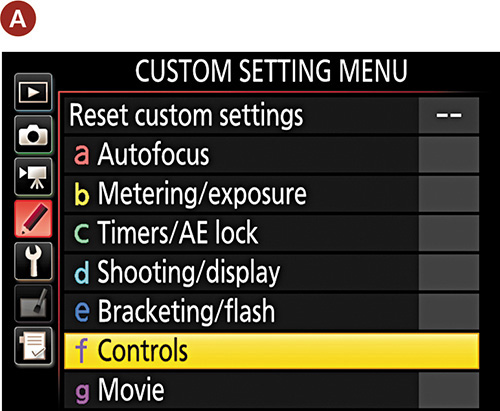
3. Scroll down to item f7 Slot empty release lock, and press OK (B).

4. Highlight LOCK Release locked, and press OK (C).

Now when you press the shutter release button without a card in the camera, you will find that the camera does nothing. This should be your cue to dig that memory card out of your camera bag.
9. Turn On Image Review
One of the things that really surprised me when I first began shooting with the D750 was that the playback for reviewing images was turned off. I am used to seeing my images on the rear LCD screen after capturing a shot, so this is one of the first things that needed addressing. When turning the review on, I adjusted the default review time (the time that the monitor stays on after capturing a shot). It’s also a good idea to check the auto-off durations for features like the menu screen. It can be very frustrating when you are trying to learn about the camera and its features and you have to keep pressing the Menu or Info button to bring the screen back to life. This is also the case when reviewing images on the screen after taking a picture. I don’t know about you, but the default time of 4 seconds to review a shot seems very short. The answer to this problem is to increase the timer settings to longer durations. The D750 has five settings for the Monitor off delay function: Playback, Menus, Information display, Image review, and Live view. All of these can be found in the Custom Setting menu under item C4 in the Timers/AE Lock section. The image review feature can be turned on in the Playback menu. After turning on the image review, I like to set my image review to 20 seconds and the information display to 1 minute. I also change the Menus setting to 5 minutes. This might seem long, but I always end up turning it off before the end of the 5 minutes. It’s just nice to have it on when I need it for a little longer.
Turning on image review
1. Press the Menu button and navigate to the Playback menu.
2. Select the Image review item, and press OK (A).
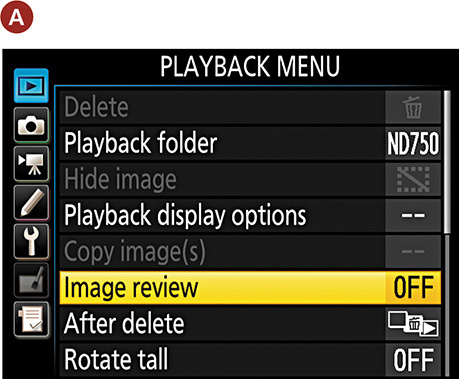
3. Highlight On, and press OK a final time to lock in your change (B).

1. Press the Menu button and navigate to the Custom Setting menu (the pencil icon).
2. Select the item labeled c Timers/AE lock, and press OK (A).

3. Use the Multi-selector to scroll down to c4 Monitor off delay, and press OK (B).
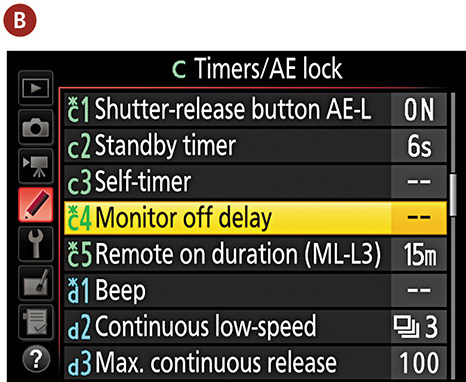
4. Select the items that need changing, such as Image review, and press OK (C).
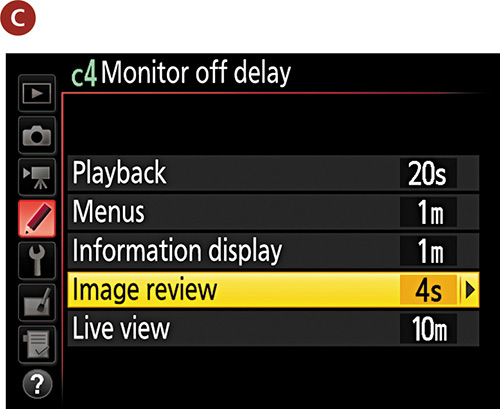
5. Highlight the desired time duration for the feature you want to adjust, and then press the OK button to lock in the change and return to the previous screen (D).

Once you have changed all of the settings, press the Menu button or the shutter button to exit the menu screen and go back to shooting mode.
10. Review Your Shots
One of the greatest features of digital cameras is their ability to give instant feedback. By reviewing your images on the camera’s LCD screen, you can instantly tell if you got your shot. This visual feedback allows you to make corrections on the fly and make certain that all of your adjustments are correct before moving on.
When you first press the shutter release button, your camera quickly processes your shot and then displays the image on the rear LCD display. The default setting for that display is only 4 seconds, which is why we changed the review times (as discussed earlier).
Since we have already adjusted the auto off timer, let’s check out some of the other visual information that will really help you when shooting.
There are two display modes that give you different amounts of information while reviewing your photos. The default view (Figure 1.6) simply displays your image along with the image filename, date, time, and image quality setting.
To get more visual feedback, press the Multi-selector up to display the second display mode, called Overview (Figure 1.7). This view mode not only displays the same information as the default view, but it also includes camera settings such as aperture, shutter speed, lens length, white balance, exposure compensation, shooting mode, ISO, white balance setting, picture control, quality setting, any compensation settings, the active color space, and the picture control. The other noticeable item will be the histogram, which gives you important feedback on the luminance values in your image.
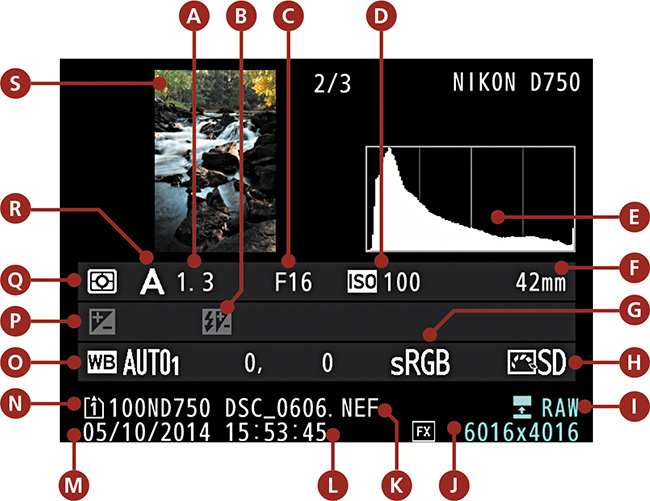
A Shutter speed
B Flash compensation
C Aperture
D ISO
E Histogram
F Lens length
G Color space
H Picture control
I Quality setting
J Image size
K File name
L Time
M Date
N Folder name
O White balance
P Exposure compensation
Q Meter setting
R Camera mode
S Image thumbnail
Figure 1.7 The Overview display mode gives you much more information.
Because the image thumbnail is so small, you probably won’t want to use this display option as your default review setting, but if you are trying to figure out what settings you used or you want to review the histogram (see the sidebar “The Value of the Histogram”), you now have all of this great information available.
There are other display options available, but they must be turned on using the camera menu. These options can be found in the Playback menu under Playback display options (Figure 1.8). With this menu option you can add display modes such as None (image only), Highlights, RGB histograms (Figure 1.9), Shooting data (Figure 1.10), and Focus point. To add these items to your display, highlight them in the menu, add a checkmark by pressing right on the Multi-selector (Figure 1.11), and, after checking all of the items you want to include, press the OK button to commit the change. Once you are done adding display options, you can review them by pressing the image review button and continually pressing up on the Multi-selector to cycle through the views.
I don’t use the RGB histogram and Shooting data settings, because they don’t offer me any visual information that I find critical during a photo session. I do, however, always have the Highlights option turned on so that I can make sure I am not clipping any information from my image highlights. (Check out the “How I Shoot” section of Chapter 4 for more information about the Highlights display view and how to use it to improve your image quality.)
Chapter 1 Assignments
Let’s begin our shooting assignments by setting up and using all the elements of the Top Ten list. Even though I have yet to cover the professional shooting modes, you should set your camera to the P (Program) mode. This will allow you to interact with the various settings and menus that have been covered thus far.
Basic camera setup
Charge your battery to 100% to get it started on a life of dependable service. Next, using your newfound knowledge, set up your camera to address the following: image quality, diopter, and color space.
Selecting the proper white balance
Take your camera outside into a daylight environment and photograph the same scene using different white balance settings. You can use Program (P) mode right now, since we haven’t covered any of the other modes. Pay close attention to how each WB setting affects the overall color cast of your images. Next, try moving inside and repeat the exercise while shooting in a tungsten lighting environment. Finally, find a fluorescent light source and repeat one more time.
Evaluating your pictures with the LCD display
Set up your image display properties and then review some of your previous assignment images using the different display modes. Review your shooting information for each image, and take a look at the histograms to see how the content of your photo affects the shape of the histograms.
Discovering the manual focus mode
Change your focus mode from auto focus to manual focus and practice a little manual focus photography. Get familiar with where the focus ring is and how to use it to achieve sharp images.
Share your results with the book’s Flickr group!
Join the group here: www.flickr.com/groups/nikond750_fromsnapshotstogreatshots

